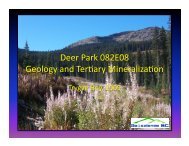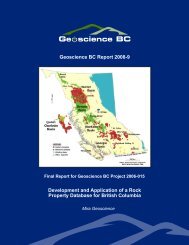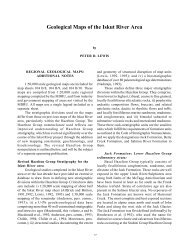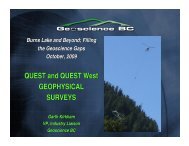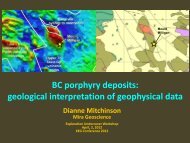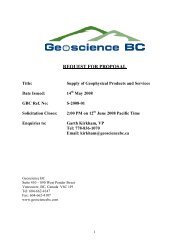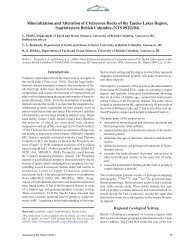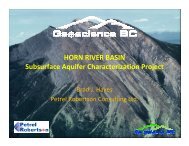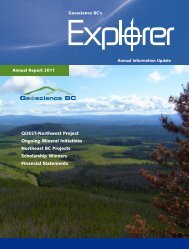Report - Geoscience BC
Report - Geoscience BC
Report - Geoscience BC
You also want an ePaper? Increase the reach of your titles
YUMPU automatically turns print PDFs into web optimized ePapers that Google loves.
Electrical Resistivity and Chargeability<br />
Complex electrical impedance frequency spectra were measured using a Solartron 1260<br />
Impedance Spectrum Analyser, based on the method of Katsube (2001). Sample cylinders were<br />
vacuum impregnated in distilled water and allowed to soak for at least 24 hours, to allow original<br />
ground water solutes precipitated in the sample porosity to dissolve and approximate original<br />
ground water conductivity. The impedance was measured with 5 frequencies per decade from 1<br />
MHz to 0.03 Hz. The scalar resistance was picked as the real impedance at the frequency which<br />
displays minimum imaginary impedance, typically around 1000 Hz. Resistivity [Ohm.m] is this<br />
resistance times the sample geometric factor, the cross section area divided by the length.<br />
Conductivity [Mho/m] is the reciprocal of the resistivity.<br />
Induced Polarization Chargeability is calculated after converting the frequency domain<br />
impedance spectrum to the time domain response to a step function, V (t)<br />
. Using the Newmont<br />
Standard, the chargeability (Sumner, 1976) is:<br />
t 1100ms<br />
(4) m = V ( t)<br />
dt V (0)<br />
T ∫ = t=<br />
440ms<br />
Table 4. Maximum and minimum values of electrical resistivity for the Nechako Basin sample<br />
suite.<br />
Maximum Value<br />
Minimum Value<br />
Electrical Resistivity (Ohm.m) 4.99 x 10 4 36.8<br />
Chargeability (ms) 55.6 1.44 x 10 -2<br />
Wet/Dry Seismic Wave Velocity Determination<br />
The values of V P are most important to the ongoing seismic surveys because the inversions<br />
of the seismic survey data are based on V P alone; values of shear wave velocities (V S ) are more<br />
difficult to invert for. It is unknown what the pore fluid pressures magnitudes are within the<br />
Nechako Basin, however, pore fluid pressure exerts a significant influence on geophysical<br />
seismic reflection and thus we feel that these measurements will be relevant.<br />
Dry and wet ultrasonic measurements were made on all cores. ‘Dry’ samples were dried<br />
under vacuum at 40°C for at least 24 hours. Subsequently, ‘wet’ ultrasonic measurements were





